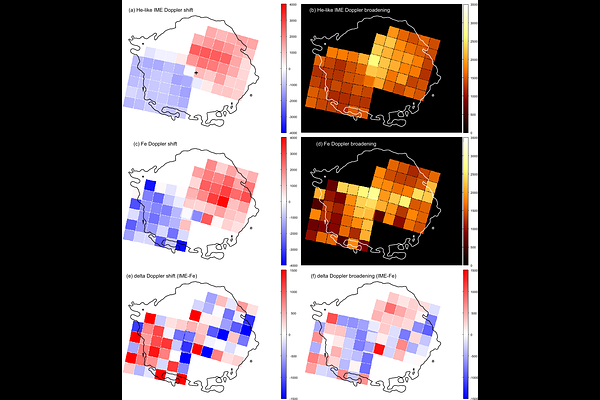Measuring the asymmetric expansion of the Fe ejecta of Cassiopeia A with XRISM/Resolve

Measuring the asymmetric expansion of the Fe ejecta of Cassiopeia A with XRISM/Resolve
Aya Bamba Department of Physics, U. Tokyo Research Center for the Early Universe, U. Tokyo Trans-Scale Quantum Science Institute, U. Tokyo, Manan Agarwal U. Amsterdam, Jacco Vink U. Amsterdam SRON, Paul Plucinsky Harvard-Smithsonian Center for Astrophysics, Yukikatsu Terada Saitama U ISAS/JAXA, Ehud Behar Technion, Satoru Katsuda Saitama U, Koji Mori U. Miyazaki, Makoto Sawada Rikkyo U, Hironori Matsumoto Osaka U, Lia Corrales U. Michigan, Adam Foster Center for Astrophysics, Harvard-Smithsonian, Shin-ichiro Fujimoto National Institute of Technology Kumamoto College, Liyi Gu SRON, Kazuhiro Ichikawa U. Miyazaki, Kai Matsunaga Kyoto U, Tsunefumi Mizuno Hiroshima U, Hiroshi Murakami Tohoku Gakuin U, Hiroshi Nakajima Kanto Gakuin U, Toshiki Sato Meiji U, Haruto Sonoda ISAS/JAXA, Shunsuke Suzuki ISAS/JAXA, Dai Tateishi Department of Physics, U. Tokyo, Hiroyuki Uchida Kyoto U, Masahiro Ichihashi Department of Physics, U. Tokyo, Kumiko Nobukawa KINDAI U, Salvatore Orlando INAF-Osservatorio Astronomico di Palermo
AbstractThe expansion structure of supernova remnants (SNRs) is important for understanding not only how heavy elements are distributed into space, but also how supernovae explode. The ejecta expansion structure of the young core-collapse SNR Cas A is investigated, with Doppler parameter mapping of the Fe-K complex by the Resolve microcalorimeter onboard the X-ray Imaging and Spectroscopy Mission, XRISM. It is found that the Fe ejecta are blueshifted in the southeast (SE) and redshifted in the northwest (NW), indicating an incomplete shell structure, similar to the intermediate mass elements (IMEs), such as Si and S. The Fe has a velocity shift of $\sim1400$ km~s$^{-1}$ in the NW and $\sim2160$ km~s$^{-1}$ in the SE region, with the error range of a few 100s km~s$^{-1}$. These values are consistent with those for the IMEs in the NW region, whereas larger than those for the IMEs in the SE region, although the large error region prevented us from concluding which component has significantly higher velocity. The line broadening is larger in the center with values of $\sim$2000--3000~km~s$^{-1}$, and smaller near the edges of the remnant. The radial profiles of the Doppler shift and broadening of the IMEs and Fe indicate that the Fe ejecta may expand asymmetrically as IME ejacta, although the large error regions do not allow us to conclude it. Moreover, we see little bulk Doppler broadening of the Fe lines in the northeastern jet region whereas the IME lines exhibit significant broadening. No such narrow lines are detected in the NW region. These findings suggest an asymmetric expansion of the ejecta potentially driven by large-scale asymmetries originating from the supernova explosion. This interpretation aligns with the large-scale asymmetries predicted by models of neutrino-driven supernova explosions.